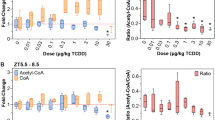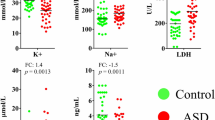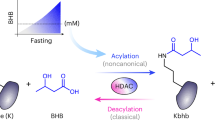Abstract
2-Methyl-3-hydroxybutyryl-CoA dehydrogenase (2M3HBD) deficiency (HSD10 disease) is a rare inborn error of metabolism, and <30 cases have been reported worldwide. This disorder is typically characterized by progressive neurodegenerative disease from 6 to 18 months of age. Here, we report the first patient with this disorder in Asia, with atypical clinical presentation. A 6-year-old boy, who had been well, presented with severe ketoacidosis following a 5-day history of gastroenteritis. Urinary organic acid analysis showed elevated excretion of 2-methyl-3-hydroxybutyrate and tiglylglycine. He was tentatively diagnosed with β-ketothiolase (T2) deficiency. However, repeated enzyme assays using lymphocytes showed normal T2 activity and no T2 mutation was found. Instead, a hemizygous c.460G>A (p.A154T) mutation was identified in the HSD17B10 gene. This mutation was not found in 258 alleles from Japanese subjects (controls). A normal level of the HSD17B10 protein was found by immunoblot analysis but no 2M3HBD enzyme activity was detected in enzyme assays using the patient’s fibroblasts. These data confirmed that this patient was affected with HSD10 disease. He has had no neurological regression until now. His fibroblasts showed punctate and fragmented mitochondrial organization by MitoTracker staining and had relatively low respiratory chain complex IV activity to those of other complexes.
Similar content being viewed by others
Log in or create a free account to read this content
Gain free access to this article, as well as selected content from this journal and more on nature.com
or
References
Zschocke J, Ruiter JP, Brand J, Lindner M, Hoffmann GF, Wanders RJ et al. Progressive infantile neurodegeneration caused by 2-methyl-3-hydroxybutyryl-CoA dehydrogenase deficiency: a novel inborn error of branched-chain fatty acid and isoleucine metabolism. Pediatr. Res. 48, 852–855 (2000).
Ofman R, Ruiter JP, Feenstra M, Duran M, Poll-The BT, Zschocke J et al. 2-Methyl-3-hydroxybutyryl-CoA dehydrogenase deficiency is caused by mutations in the HADH2 gene. Am. J. Hum. Genet. 72, 1300–1307 (2003).
Yang SY, He XY & Miller D HSD17B10: a gene involved in cognitive function through metabolism of isoleucine and neuroactive steroids. Mol. Genet. Metab. 92, 36–42 (2007).
Yang SY, He XY & Schulz H Multiple functions of type 10 17beta-hydroxysteroid dehydrogenase. Trends Endocrinol. Metab. 16, 167–175 (2005).
Zschocke J HSD10 disease: clinical consequences of mutations in the HSD17B10 gene. J. Inherited Metab. Dis 35, 81–89 (2012).
Holzmann J, Frank P, Loffler E, Bennett KL, Gerner C & Rossmanith W RNase P without RNA: identification and functional reconstitution of the human mitochondrial tRNA processing enzyme. Cell 135, 462–474 (2008).
Fukao T, Scriver CR & Kondo N The clinical phenotype and outcome of mitochondrial acetoacetyl-CoA thiolase deficiency (beta-ketothiolase or T2 deficiency) in 26 enzymatically proved and mutation-defined patients. Mol. Genet. Metab. 72, 109–114 (2001).
Mitchell GA & Fukao T in The Metabolic & Molecular Basis of Inherited Disease Vol. 2, Ch. 102 (eds Scriver, C. R., Beaudet, A. L., Sly, W. S. & Valle D.) 2327–2356 (McGraw-Hill, New York, 2001).
Cazorla MR, Verdu A, Perez-Cerda C & Ribes A Neuroimage findings in 2-methyl-3-hydroxybutyryl-CoA dehydrogenase deficiency. Pediatr. Neurol. 36, 264–267 (2007).
Ensenauer R, Niederhoff H, Ruiter JP, Wanders RJ, Schwab KO, Brandis M et al. Clinical variability in 3-hydroxy-2-methylbutyryl-CoA dehydrogenase deficiency. Ann. Neurol. 51, 656–659 (2002).
Garcia-Villoria J, Gort L, Madrigal I, Fons C, Fernandez C, Navarro-Sastre A et al. X-inactivation of HSD17B10 revealed by cDNA analysis in two female patients with 17beta-hydroxysteroid dehydrogenase 10 deficiency. Eur. J. Hum. Genet 18, 1353–1355 (2010).
Garcia-Villoria J, Navarro-Sastre A, Fons C, Perez-Cerda C, Baldellou A, Fuentes-Castello MA et al. Study of patients and carriers with 2-methyl-3-hydroxybutyryl-CoA dehydrogenase (MHBD) deficiency: difficulties in the diagnosis. Clin. Biochem. 42, 27–33 (2009).
Lenski C, Kooy RF, Reyniers E, Loessner D, Wanders RJ, Winnepenninckx B et al. The reduced expression of the HADH2 protein causes X-linked mental retardation, choreoathetosis, and abnormal behavior. Am. J. Hum. Genet. 80, 372–377 (2007).
Olpin SE, Pollitt RJ, McMenamin J, Manning NJ, Besley G, Ruiter JP et al. 2-Methyl-3-hydroxybutyryl-CoA dehydrogenase deficiency in a 23-year-old man. J. Inherited Metab. Dis 25, 477–482 (2002).
Perez-Cerda C, Garcia-Villoria J, Ofman R, Sala PR, Merinero B, Ramos J et al. 2-Methyl-3-hydroxybutyryl-CoA dehydrogenase (MHBD) deficiency: an X-linked inborn error of isoleucine metabolism that may mimic a mitochondrial disease. Pediatr. Res. 58, 488–491 (2005).
Poll-The BT, Wanders RJ, Ruiter JP, Ofman R, Majoie CB, Barth PG et al. Spastic diplegia and periventricular white matter abnormalities in 2-methyl-3-hydroxybutyryl-CoA dehydrogenase deficiency, a defect of isoleucine metabolism: differential diagnosis with hypoxic-ischemic brain diseases. Mol. Genet. Metab. 81, 295–299 (2004).
Rauschenberger K, Scholer K, Sass JO, Sauer S, Djuric Z, Rumig C et al. A non-enzymatic function of 17beta-hydroxysteroid dehydrogenase type 10 is required for mitochondrial integrity and cell survival. EMBO Mol. Med 2, 51–62 (2010).
Sass JO, Forstner R & Sperl W 2-Methyl-3-hydroxybutyryl-CoA dehydrogenase deficiency: impaired catabolism of isoleucine presenting as neurodegenerative disease. Brain Dev 26, 12–14 (2004).
Seaver LH, He XY, Abe K, Cowan T, Enns GM, Sweetman L et al. A novel mutation in the HSD17B10 gene of a 10-year-old boy with refractory epilepsy, choreoathetosis and learning disability. PLoS ONE 6, e27348 (2011).
Sutton VR, O'Brien WE, Clark GD, Kim J & Wanders RJ 3-Hydroxy-2-methylbutyryl-CoA dehydrogenase deficiency. J. Inherited Metab. Dis 26, 69–71 (2003).
Yang SY, He XY, Olpin SE, Sutton VR, McMenamin J, Philipp M et al. Mental retardation linked to mutations in the HSD17B10 gene interfering with neurosteroid and isoleucine metabolism. Proc. Natl Acad. Sci. USA 106, 14820–14824 (2009).
Fukao T, Song XQ, Mitchell GA, Yamaguchi S, Sukegawa K, Orii T et al. Enzymes of ketone body utilization in human tissues: protein and messenger RNA levels of succinyl-coenzyme A (CoA):3-ketoacid CoA transferase and mitochondrial and cytosolic acetoacetyl-CoA thiolases. Pediatr. Res. 42, 498–502 (1997).
Fukao T, Nakamura H, Song XQ, Nakamura K, Orii KE, Kohno Y et al. Characterization of N93S, I312T, and A333P missense mutations in two Japanese families with mitochondrial acetoacetyl-CoA thiolase deficiency. Hum. Mutat. 12, 245–254 (1998).
Kirby DM, Crawford M, Cleary MA, Dahl HH, Dennett X & Thorburn DR Respiratory chain complex I deficiency: an underdiagnosed energy generation disorder. Neurology 52, 1255–1264 (1999).
Schagger H & von Jagow G Blue native electrophoresis for isolation of membrane protein complexes in enzymatically active form. Anal. Biochem. 199, 223–231 (1991).
Kirby DM, Salemi R, Sugiana C, Ohtake A, Parry L, Bell KM et al. NDUFS6 mutations are a novel cause of lethal neonatal mitochondrial complex I deficiency. J. Clin. Invest. 114, 837–845 (2004).
Bernier FP, Boneh A, Dennett X, Chow CW, Cleary MA & Thorburn DR Diagnostic criteria for respiratory chain disorders in adults and children. Neurology 59, 1406–1411 (2002).
Benach J, Filling C, Oppermann UC, Roversi P, Bricogne G, Berndt KD et al. Structure of bacterial 3beta/17beta-hydroxysteroid dehydrogenase at 1.2 A resolution: a model for multiple steroid recognition. Biochemistry. 41, 14659–14668 (2002).
Persson B, Kallberg Y, Bray JE, Bruford E, Dellaporta SL, Favia AD et al. The SDR (short-chain dehydrogenase/reductase and related enzymes) nomenclature initiative. Chemico-Biological Interactions 178, 94–98 (2009).
Yang SY, He XY & Miller D Hydroxysteroid (17beta) dehydrogenase X in human health and disease. Mol. Cell Endocrinol. 343, 1–6 (2011).
Deutschmann AJ, Amberger A, Zavadil C, Steinbeisser H, Mayr JA, Feichtinger RG et al. Mutation or knock-down of 17beta-hydroxysteroid dehydrogenase type 10 cause loss of MRPP1 and impaired processing of mitochondrial heavy strand transcripts. Hum. Mol. Genet. 23, 3618–3628 (2014).
Acknowledgements
We sincerely thank Dr Jos PN Ruiter, Professor Ronald JA Wanders and Professor Bwee Tien Poll-The for providing the fibroblast cell line from an HSD10-deficient patient as a positive control and giving a protocol for the 2M3HBD enzyme assay.
Author information
Authors and Affiliations
Corresponding author
Ethics declarations
Competing interests
The authors declare no conflict of interest.
Additional information
Supplementary Information accompanies the paper on Journal of Human Genetics website
Rights and permissions
About this article
Cite this article
Fukao, T., Akiba, K., Goto, M. et al. The first case in Asia of 2-methyl-3-hydroxybutyryl-CoA dehydrogenase deficiency (HSD10 disease) with atypical presentation. J Hum Genet 59, 609–614 (2014). https://doi.org/10.1038/jhg.2014.79
Received:
Revised:
Accepted:
Published:
Issue date:
DOI: https://doi.org/10.1038/jhg.2014.79
This article is cited by
-
Lost in promiscuity? An evolutionary and biochemical evaluation of HSD10 function in cardiolipin metabolism
Cellular and Molecular Life Sciences (2022)
-
C4OH is a potential newborn screening marker—a multicenter retrospective study of patients with beta-ketothiolase deficiency in China
Orphanet Journal of Rare Diseases (2021)
-
Clinical and molecular analysis of 6 Chinese patients with isoleucine metabolism defects: identification of 3 novel mutations in the HSD17B10 and ACAT1 gene
Metabolic Brain Disease (2017)



